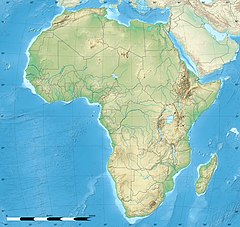| Heptamegacanthus | |
|---|---|
| Scientific classification | |
| Domain: | Eukaryota |
| Kingdom: | Animalia |
| Phylum: | Acanthocephala |
| Class: | Archiacanthocephala |
| Order: | Oligacanthorhynchida |
| Family: | Oligacanthorhynchidae |
| Genus: | Heptamegacanthus Spencer-Jones, 1990[1] |
| Species: | H. niekerki
|
| Binomial name | |
| Heptamegacanthus niekerki Spencer-Jones, 1990
| |
Heptamegacanthus is a monotypic genus of acanthocephalans (thorny-headed or spiny-headed parasitic worms). It contains a single species, Heptamegacanthus niekerki, parasite of the endangered giant golden mole (Chrysospalax trevelyani) found only in isolated forests near East London and in the Transkei, both in South Africa. Its body consists of a proboscis armed with hooks which it uses to pierce and hold the rectal wall of its host, and a short, wide trunk. There are 40 to 45 of these hooks arranged in rings that are not radially symmetrical, with seven large anterior hooks. The hooks in the anterior ring are twice as large as those in the second ring and the remaining hooks decrease progressively in size posteriorly. The worms are about 4 millimetres (0.2 in) long and 2 millimetres (0.08 in) wide with minimal sexual dimorphism.
The life cycle of H. niekerki remains unknown; however, like other acanthocephalans, it likely involves complex life cycles with at least two hosts. Although the intermediate host for Heptamegacanthus is not definitively identified, it is presumed to be an arthropod. In this host, the larvae develop into an infectious stage known as a cystacanth. These are then ingested by the definitive host, where they mature and reproduce sexually within the intestines. The resulting eggs are expelled and hatch into new larvae.
